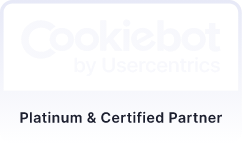Deciding between two content management systems (CMS) is no easy task. Your CMS is an important long-term investment, so you must ensure you choose a platform that will meet all your requirements, both now and in future.
If you’re currently weighing up the pros and cons between Contentful and WordPress, there are some key differences between the two platforms that you should be aware of.
To make this evaluation process easier for you, and help you pick the best option for your business, this article provides a direct, objective comparison between these platforms.
Platform Overviews
Different types of software will provide you with different capabilities and limitations. The Contentful and WordPress platforms can both deliver quality enterprise-grade websites, but they each take a slightly different approach.
Contentful
Contentful is a cloud-based “headless” CMS. Being headless means that the back-end of the platform you use to publish, edit, and manage content is not directly connected to the front-end of your live website.
Your content is managed and stored in one central hub, hosted within the cloud, and this is the back-end of your platform (also known as the “body”). APIs are then used to take your content from the back-end and present it in website form.
A headless CMS gives you a high level of flexibility and customisation with your website’s front-end. These same APIs allow you to publish your content in different formats in different channels as well, facilitating a multi-channel approach to marketing.
This makes Contentful a flexible platform that can meet a range of different content requirements, but it is admittedly more complicated than the traditional approach to website management.
WordPress
WordPress is a traditional CMS that provides a more straightforward approach to managing your website. You can use WordPress to build sophisticated, dynamic sites with a simple, user-friendly set of tools.
While most businesses use WordPress in the traditional way, the platform can be leveraged with a headless approach as well, allowing it to match the scalability and multi-channel capabilities of solutions like Contentful.
WordPress gives you the flexibility to choose how you’d like to develop your website, based on the complexity and size of the project, and the objectives you’re trying to achieve. In the likely case that you’re working with a web design and development agency, that can all be handled for you by your partner.
The Scalability of Each Platform
Your business will grow and evolve over time, so you need a platform that can quickly and easily scale up with new features and functionality. You also need to ensure the platform can handle high volumes of traffic and maintain performance as your audience grows. That’s why scalability is one of the most important aspects to consider when choosing a CMS.
How Scalable is Contentful?
One of the main benefits of a headless CMS is that the infrastructure allows you to grow your digital presence rapidly, on a large scale.
The back-end offers easy customisation, and the cloud-based nature of the platform allows you to scale up dynamically whenever you need to.
Its multi-channel capabilities also inherently promote the idea of developing your content in different formats at a larger scale, while always maintaining consistency. This enables you to produce individual pieces of content once and easily repurpose them across different channels a number of times, saving valuable time and resources.
This can all be done without any concerns over technical issues like server capacity or network bandwidth, because the platform is delivered in a software-as-a-service (SaaS) model.
How Scalable is WordPress?
WordPress is a highly scalable platform in its own right, currently used to power the websites of some of the largest and most successful businesses in the world.
The platform is agile and scalable enough to grow seamlessly alongside your business and adapt to your changing requirements, whichever way you decide to use it.
As mentioned earlier, taking the headless approach with WordPress can provide the same enhanced scalability and pervasive multi-channel capabilities as Contentful, if you require those aspects from your CMS. This can also deliver benefits with speed of development and time-to-market, saving you valuable costs with your agency partner.
Expanding your WordPress site with the more traditional approach is made even easier than most other CMSs as well, thanks to the platform’s unique block-based editor. This is a method of building websites that provides great benefits in the areas of flexibility, efficiency, and ease-of-use.
WordPress also allows you to continually enhance your site with new features and functionality through bespoke development, with almost no limitations on what can be achieved.
Ease-of-Use
Like all technology, some tools are more approachable for the majority of users, while others will require some existing skills. This makes ease-of-use a key part of your criteria when selecting a platform to manage your website. You’ll be using it almost every day, after all, so you need to be comfortable with it.
How Easy is Contentful to Use?
While Contentful being solely a headless CMS does have its advantages, such as scalability and customisation, this approach also creates some challenges for the average user.
For example, adding content to Contentful can be difficult because it doesn’t provide you with a way to preview how your content will look in the front-end of the website.
Contentful doesn’t have a simple editing interface on the front-end, so there’s a much higher risk of error with this platform than with most others.
Granted, Contentful’s user interface (UI) is well structured and intuitive, but it’s also known for being more difficult for non-technical users than platforms like WordPress.
Handling the API rules is also complicated without the help of an experienced web development team. If you’re working with an agency, you may end up calling on them regularly for tasks that you could likely handle yourself in other CMSs.
How Easy is WordPress to Use?
Conversely, WordPress is renowned for its simplicity and ease-of-use. Even if you don’t have any existing knowledge of coding or content management, WordPress is very approachable and easy to learn.
When you first get started with WordPress, virtually everything you need to set up and manage your website will be readily available within the platform.
Publishing, managing, and editing in WordPress are all quick and convenient, thanks to an intuitive back-end that provides you with everything you need to build out a content-rich website.
Thanks to this ease-of-use, most of the people within your team will be able to use WordPress, allowing you to share the responsibility of the daily management and running of your site.
It is worth noting that taking a headless approach with WordPress does also require experienced web developers to be able to manage the platform though.
Security
Security should always be a top priority with any software you introduce into your business. If you’re considering a CMS that seems like it could be unable to provide the enterprise-grade security you need, it’s wise to continue looking for more reliable alternatives.
How Secure is Contentful?
As a cloud-based SaaS product, Contentful comes with useful in-built security features, including HTTPS data encryption, role-based access controls, and multi-factor authentication.
Headless CMSs also take a different approach to security compared to traditional platforms like WordPress. Its use of APIs allows you to control access to your content through a token-based authentication system, and it uses industry-standard encryption and secure storage measures to protect your data. With that in mind, Contentful should be seen as a very secure and robust platform.
How Secure is WordPress?
WordPress is a secure, platform. To find proof of this, you only need to look as far as the wealth of global enterprise businesses that have chosen WordPress as their CMS.
As with any software, though, there will always be vulnerabilities or potential risks that can arise in certain scenarios. For example, WordPress regularly releases updates to its software, and failing to test your platform upon these releases could lead to bugs or security issues creeping in. Similarly, certain plugins can create security problems if taken from the wrong sources or left untested for too long.
Finding an experienced agency partner you can depend on is usually a wise move to reinforce the security of your website. That partner will also be able to support you with important related services like hosting, maintenance, and ongoing optimisation.
Cost and TCO
Your CMS also needs to deliver good value for money and a low total cost of ownership (TCO).
To understand your long-term TCO, you’ll need to take into account things like license fees, hosting costs, maintenance, bespoke development with your agency, and more.
Contentful’s Initial Costs and Ongoing Investment
Contentful has basic and premium pricing plans for businesses, although you can use the platform for free to see if it’s a good fit first.
The basic plan starts at around £250 per month and supports up to twenty users, so it’s only suitable for small businesses. The premium plan is priced based on the resources you’ll use, such as number of users, API requests, and storage. You can usually expect this to start at around £450 per month.
However, as mentioned earlier, most businesses will require a lot of support from an agency to get the platform set up in both the back-end and front-end. You’ll likely need ongoing work from an agency to ensure you can use the platform to its full potential as well, which won’t come cheap.
All these things tend to add up to a high TCO over time, making Contentful less cost-efficient than some of the other CMSs around today.
WordPress’s Low TCO
WordPress is one of those solutions that is far more cost-efficient than Contentful, with a much more reasonable TCO.
Its software is open-source and the platform free to use. This means your initial costs are limited to just hosting, agency fees, and any other support you may need once your site is live. Plugins and extensions of the platform are licensed and paid for separately.
As WordPress is such an intuitive and easy-to-use platform, it’s also affordable to run it and manage it, even if you do use an agency to handle that for you. This includes any bespoke development or customisation requirements you may have, which experienced agencies can often deliver with a very fast time-to-market as well.
Which Platform is Right for You?
Both these CMSs will enable you to build sophisticated, high-performance websites that will support your business goals and allow you to gain an edge over your competition.
As you’ve seen throughout this comparison article, they each have their strengths and weaknesses, as do all the other CMSs available today. That means you need to base your decision on which one is the best fit for your specific business.
For example, a headless CMS, whether that’s Contentful or WordPress, may be too complex in many cases. But if you’re looking to execute a holistic multi-channel marketing strategy, it might be the right choice for you.
In the early stages of your evaluation process, it’s crucial to carefully consider your own unique requirements, objectives, budget, resources, agency relationships, and various other factors.
In order to make the right decision between two CMSs, you need to understand which one will be more suitable to deliver on your needs and expectations, both in the immediate term and for years to come.
Still not convinced? Discover five key benefits of WordPress’s industry-leading scalability in our related article here.
Would you like these insights straight to your mailbox?
- Plugins
- Bespoke development.
- Does it have a large number of positive reviews?
- Is it built by an author with a good reputation?
- How active and trusted is the author in the WordPress community?
- When was the last date the plugin was updated?
- Has it been updated regularly enough in the past?
- Does the code quality meet our standards?
- Does the code align with modern WordPress development best practices?
- Is the plugin compatible with the WordPress block editor?
- Demographics
- Goals
- Challenges
- Motivations
- Preferences
- Frustrations.
- Design look and feel
- Structure and navigation
- Features and functionality
- User experience
- Content and layout
- Calls-to-action
- Speed and performance
- And anything else relevant to your project.
- Design
- Development
- Quality Assurance Testing
- Migration and Launch.
- Strategy
- Website Data
- Target Audience
- Industry Landscape
- Competitors.
- Your target audience now has a shorter attention span, and less patience when browsing websites and services online
- Your target audience also has more choice of options than ever before when choosing who to buy from.
Development
21 June, 2023
How to Determine When to Use WordPress Plugins and When to Use Bespoke Development
When developing a high-performance website with WordPress, certain requirements will demand that your agency partner goes beyond the “out-the-box” functionality of the platform.
There are two main ways your agency partner may work with you to build out custom functionality:
While plugins are the go-to option for many small and medium-sized businesses, it shouldn’t always be such a quick decision between those two options. If you’re working on an enterprise-grade website, your agency should always give careful consideration when determining the best approach in every scenario.
In this article, we’ll help you understand how to determine the right option between plugins and bespoke development for your own WordPress website.
Why Are WordPress Plugins so Popular?
Since WordPress is an open-source platform with a very active global community of web developers, there are tens of thousands of plugins readily available. For almost any use case you can think of, there’s almost certainly a plugin for it; probably even several.
Plugins serve so many businesses so well because they’re pre-built functionality that quite literally plugs into your platform.
One of the main reasons plugins are so popular, especially for smaller businesses, is because they’re usually free. This provides a great cost benefit over bespoke development, on top of the obvious benefits in the speed of attaining the new functionality as well.
Why You Should be Careful with Plugins
Despite their popularity, there are downsides to plugins too.
Relying on too many plugins, or using low quality plugins, may slow the speed of your site down significantly. A good WordPress development agency will try to keep the use of plugins at a minimum to ensure the speed and performance of your site isn’t compromised.
Poorly built plugins, or ones that aren’t maintained sufficiently, could also cause glitches and errors to occur with the functionality they’re adding to your site.
Security is another concern with certain plugins. If a plugin isn’t maintained and updated regularly, this will create vulnerabilities in your platform that could be exploited by malware or cyber security attacks. These vulnerabilities could also creep in if your plugins are auto-updated and left untested by your agency partner.
Some less experienced agencies often fall into the trap of using too many plugins, while others are simply unaware of the risks associated with plugins from untrusted sources. This has given a bad impression of plugins in some circles. The missing ingredient there, however, isn’t the value of plugins, it’s the agency’s best practices.
When to Use WordPress Plugins
If there’s a feature you need to add to your site that’s already been built perfectly in a trustworthy plugin, it’s worth considering that approach instead of building something from scratch.
However, here at SoBold, we ensure a strict set of best practices are followed, and due diligence conducted, every time we’re considering using a plugin.
We’ll always make thorough checks to ensure any plugin we use is best-in-class, aligned with our high-performance standards, and so should any other agency you work with.
This will include asking questions like:
Before implementing a plugin on your platform, your agency should also use it in a local testing environment to ensure it functions as expected.
The majority of plugins are reliable, offering a quicker and easier approach than building something bespoke. However, there are many cases where bespoke development is the more suitable option.
When it’s Better to Use Bespoke Development
When it comes to sophisticated, dynamic websites, plugins may not be capable of delivering the required level of performance, security compliance, or functionality.
In these cases, your agency will turn to bespoke development to deliver what you need. This is often the necessary approach, because high-performance websites do require some complexity behind the scenes. And WordPress is arguably the best platform available today for bespoke web development.
Building out your platform by creating new features completely from scratch, tailored to your exact need, brings with it a wealth of advantages over using plugins.
This is particularly beneficial in terms of flexibility and customisation, giving you something entirely unique to your website. You’ll have complete control and ownership of your bespoke features, which provides greater security and seamless integrations with the rest of your technology systems.
Performance will almost always be superior with bespoke development, delivering a far greater user experience (UX) and improving your customer engagement as a result.
Bespoke development could even be more cost-effective in the long-run too, when compared to plugins that turn out to be problematic or aren’t updated past a certain point.
Rely on Your Agency’s Expertise
Determining whether to use a plugin or build something bespoke will be a decision your agency should guide you to make correctly.
Each website and each business are different, so the right option will be unique to your own requirements and circumstances. Therefore, it’s also worth mentioning that this must be specific to each individual requirement as well, rather than taking a blanket approach.
The decision shouldl be based on the most straightforward way to give you the capability you’re looking for. It will also involve ensuring that your site’s security, performance, and UX are maintained. Another important factor to consider are your circumstances, such as your budget, timeframes, the amount of traffic your website is likely to encounter, and so on.
For example, if your agency knows that one of your top priorities for your website is excellent performance, they’ll make different decisions in that case than they would if you were more concerned with the fastest possible time-to-market.
Some businesses even use plugins in the first phase of their website, then look to rebuild their plugin-based functionality with bespoke development when their business grows, or when they have more time and resources available.
It’s important to trust your agency partner with this decision and rely on their advice. This is why it’s so valuable to work with an experienced agency who understands your needs, so they can help you make the right choices and take the best possible option.
Finding the Right Balance for Your Website
Plugins can be very useful, and it must be said that many WordPress plugins are outstanding in their capability and quality. However, if your specific requirements demand more than a plugin can deliver, bespoke development will be the correct approach.
Regardless, it’s crucial to find the right balance to ensure your site’s performance, speed, and security are maintained.
Ultimately, your agency partner should always consider the specific requirements and circumstances of your project before deciding whether to use plugins or build bespoke functionality for your site. This makes it even more important to work with an experienced agency you can trust to guide you.
Discover more about the scalability and flexibility of the WordPress platform, and its ability to deliver complex requirements for enterprise websites, in our related article here: Just How Scalable is WordPress?
Would you like these insights straight to your mailbox?
UI Design
18 April, 2023
Understanding the Important Role of Research and Planning When Designing a New Website
Before you begin working on the design elements of a website project, it’s important to begin with, what we at SoBold call, a research and planning phase.
The purpose of a research and planning phase is to ensure that every single decision you make about your design will result in a more effective website, both in terms of your business goals and your users’ needs.
During this phase, you’ll work alongside your chosen agency to define the full scope of your website and all its requirements. This phase will also involve looking closely at your target audience, trends in your market, your competitors, and any data available from your existing website.
This research is extremely useful in shaping the direction you take with your website and helping you to capitalise on certain trends that may align with your strategic objectives.
In this article, we’ll explain how a research and planning phase works to help you know what to expect when entering your own website design project.
If you’d first like to gain a better understanding of the full end-to-end process of web design, read our previous article here.
Website Strategy Workshop
A research and planning phase usually begins with a strategic workshop. This workshop will bring all the relevant stakeholders together, either in person or over a video call, to agree on the goals and parameters of the project.
A workshop is a great collaborative environment to help your agency become even more familiar with your brand, your target audience, and the outcomes you’re looking for from your new website.
Your agency should work closely with you to determine how the objectives you have for your new website feed into your wider business goals. That will be the key to finding the right approach to designing your website.
Once the workshop is completed, the research can begin.
Leveraging Data to Dictate User Experience (UX) Decisions
Every decision you make about your website’s design needs to be informed and justified by data.
As it’s becoming increasingly difficult to capture and retain your audience’s attention, nothing can be left to chance. It’s also negligent to overlook the vast range of valuable insights available to you within your data, and the data in the public domain.
Google Analytics
Your agency should begin by analysing the performance of your website in Google Analytics. This can help to help understand the current behaviours and trends from your website users.
Most businesses use Google Analytics, but few understand the right things to measure. For many businesses, Google Analytics is an untapped gold mine of data and insights that can help you improve site engagement, retain more visitors, and ultimately grow your business.
You can conduct a thorough analysis of things like:
1 – Your Audience Acquisition
Google Analytics can help you identify where your visitors have found you and accessed your website from.
Whether through organic search, social media, direct, or referral, you’ll learn how all your visitors are acquired. This information is vital, as it can allow you to tailor different parts of your website to certain visitors at various stages of their journey with you.
For example, if organic traffic is a key driver of your website traffic, it’s important for your agency to ensure that lots of the hierarchical structure of copy is maintained throughout the site.
This is also helpful in optimising your wider digital marketing strategy, by recognising what’s working well and what isn’t, from a web traffic perspective.
Bonus Tip – If you’re running Google Adwords, make sure your agency partner is aware of all the URLs that need to be redirected, and that this doesn’t affect your ad spend.
2 – Your Visitors’ Demographics
Google Analytics can provide detailed insights into your website’s visitors, with data covering everything from age, gender, location, language, and more. This helps you gain a clear, specific understanding of who’s coming to your website, and that can inform important decisions about your design.
It will also help you determine whether or not you’re attracting the right audience, which could alert you to a need for changes in your design and branding.
Bonus Tip – If you have a lot of visitors from other countries, you may need to talk to your agency about setting up a content delivery network (CDN) on the hosting server to deliver content from that location.
3 – Your Visitors’ Interests
You can use Google Analytics to view information about your visitors’ interests, past searches, and other online behaviour. This can help you identify what they’re looking for when they’re visiting your site. You can then tailor your design and content to match any unaddressed questions, challenges, or needs they might be looking to meet.
4 – Your Visitors’ Behaviour
Google Analytics can give you a graphical representation of your visitors’ behaviour when interacting with your site. This includes where they’ve entered your site, where they went next, what their whole journey through your site looks like, and where they eventually left.
This provides great opportunities to optimise certain pages that aren’t performing well enough. You can also learn what your visitors respond well to from pages that already have strong engagement.
Mapping your users’ journeys may also uncover insights to help you create links between certain services, hone in on special offers that will drive increased conversions, and many other ways to boost engagement.
5 – Your Conversions
Your conversions are a critical measurement of your site’s success. Whether you’re aiming for subscriptions, demo sign-ups, contact form submissions, downloads, or anything else, failing to achieve your conversion targets means something isn’t working.
You can use Google Analytics to set goals for conversions, monitor performance, and highlight areas where you need to improve.
Taking this analytical approach will ensure your website’s design is tailored to supporting your strategic objectives.
Bonus Tip – On July 1, 2023, for continued website measurement, you’ll need to migrate your original property settings to a Google Analytics 4 (GA4) property. Your agency partner should be on top of this though.
Data Tracking
Next, if applicable, your agency should review any existing tracking resources you have in place on your website.
A successful website design is based on many different factors, each an important component in engaging your audience, converting them into clients, and growing your business.
This is why it’s useful to look into key metrics you may use to measure your success against, then use the related data and analytics to inform your design. Tailoring your UX based on your findings will ensure your website is designed specifically to optimise your user behaviours.
Bonus Tip – If you don’t have any additional tracking in place, both HotJar and Crazy Egg are great tools to use.
Analysing External Factors
Understanding Your Target Audience
One of the most important parts of building a new website is understanding the preferences of the audience you’re targeting. You know what your ideal customer profiles (ICP) look like, but do you understand how they behave when interacting with websites online?
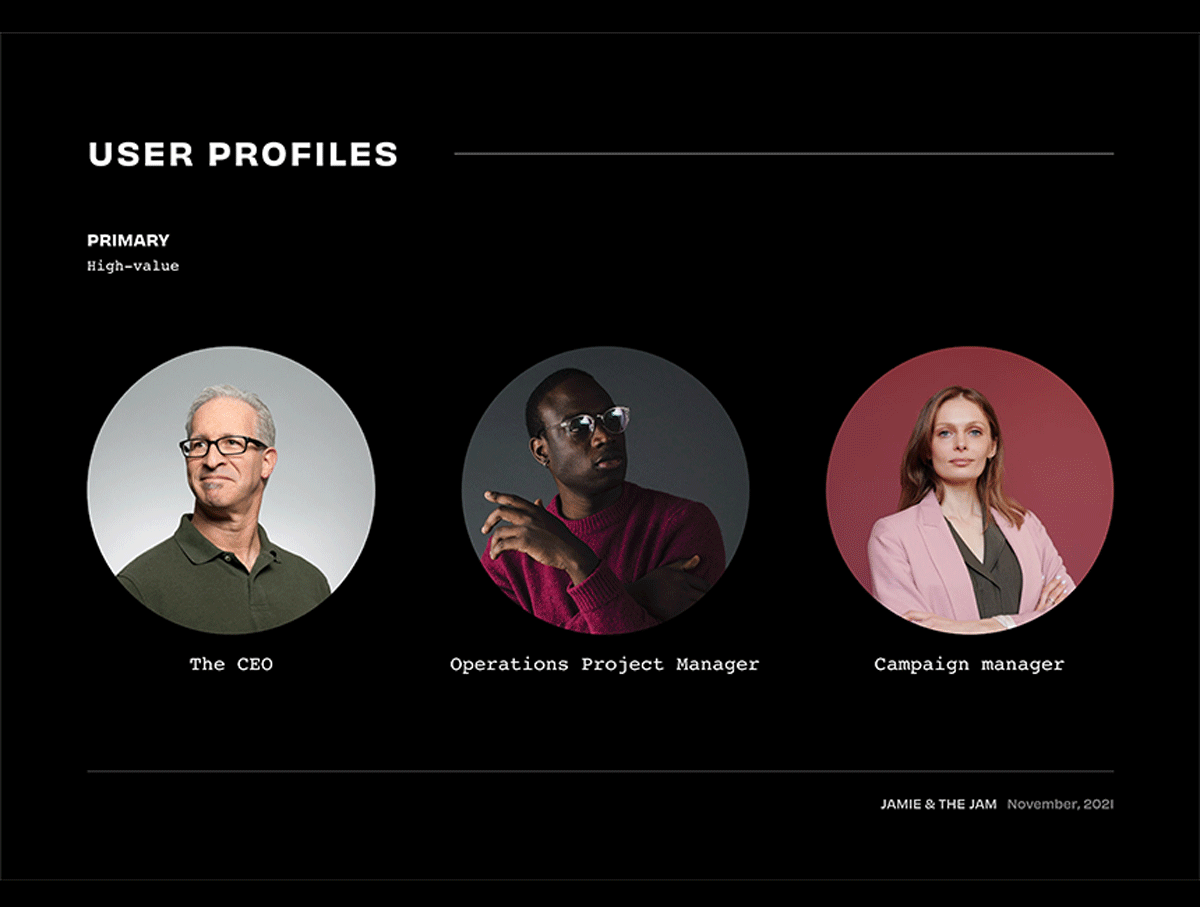
Every decision about your website’s design must be made with consideration and empathy for your users. As touched on in the previous section, audience research will include a wide range of variables, including:
This part of the research will contribute towards building user personas and user journeys at a later stage of the design process.
A user persona is a fictional person that you can use to represent the target audience of your website. These personas will help you focus on the desired interactions between the ideal user and the website you’re building. Creating personas also helps to map the users’ needs to your goals for the project.
A user journey is a path that a user may take to reach their goal when using your website. Hypothetical user journeys are created at this stage, as they help to identify the different ways the site’s design needs to enable the user to achieve their goal as quickly and easily as possible.
With these, you can begin to paint a picture of how your target audience will interact with your website, allowing you to create a satisfying user experience.
Industry Landscape
Researching your industry landscape will reveal a great deal about what to do, and what not to do. An analysis of the wider market you operate in will help you benchmark yourself against industry leaders, and highlight mistakes being made by any businesses lagging behind. It’s useful to be aware of any industry trends or points of influence that may inform your website’s design as well.
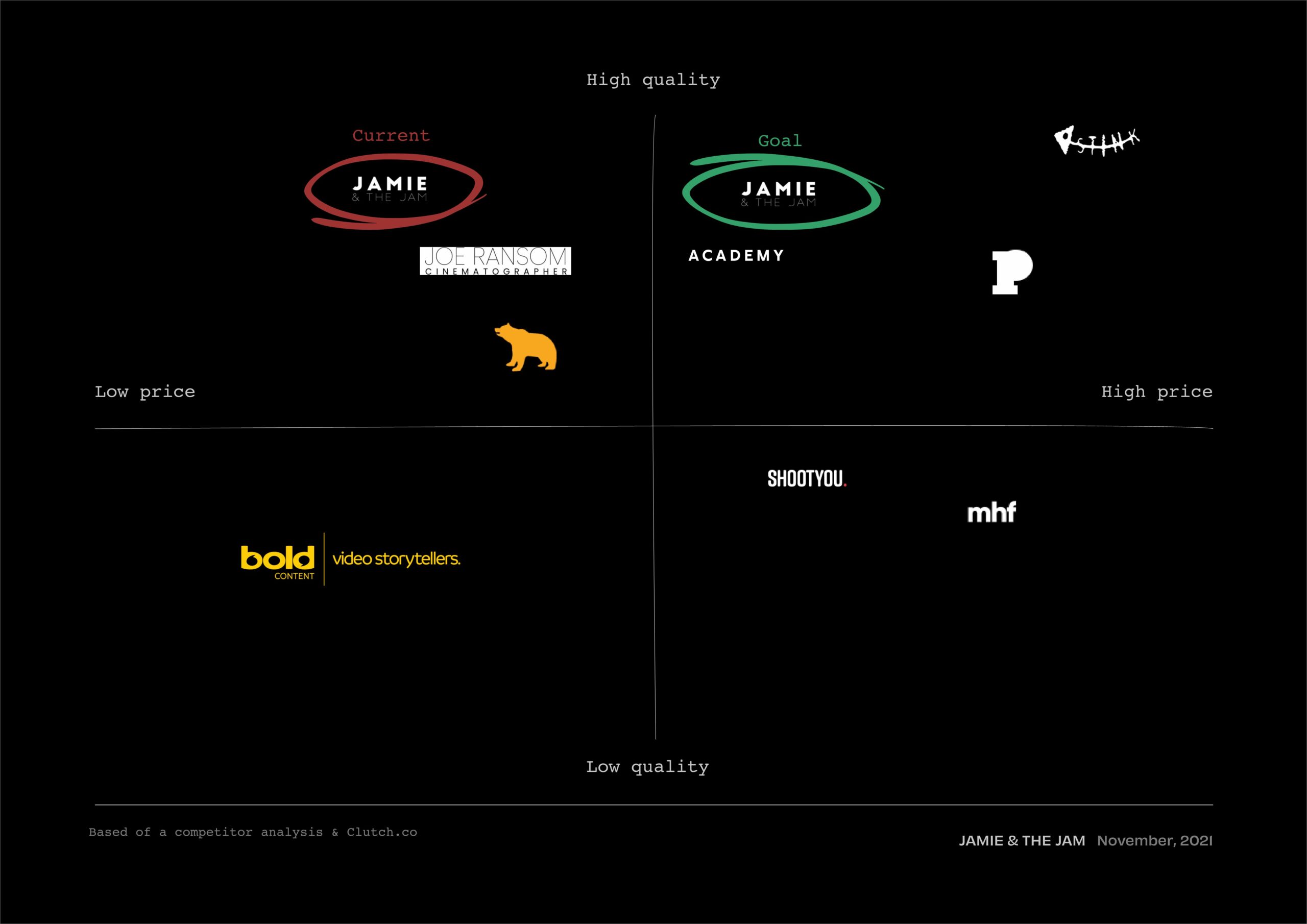
Bonus Tip – You’re an expert in your industry. Your agency is not, but they are experts in web design and marketing trends. Work closely together by leveraging each other’s knowledge and expertise to paint the full picture of what makes modern websites successful from a design perspective.
Competitor Research
It’s also crucial to conduct a thorough competitor analysis to see what the benchmark is for a successful website in your industry. Conversely, some competitors may provide examples of bad design that can help you identify pitfalls to avoid with your own site.
Around five of your competitors is usually a good number to look into. To do this, your agency should work with you on assessing their websites in key areas such as:
This research will allow you to recognise opportunities, gaps in the market, important trends, and any other insights you can gather.
Making Data-Driven Decisions
Following all this research, your agency will work on developing a strategy for your website, recommending the optimum route through the rest of the design process.
Your agency will provide a report detailing all the findings from the strategy workshop and research. This should often include a sitemap document and a content framework for your site as well.
An agency should always provide the opportunity for feedback and iterations on crucial documents like this, so you should then be given time to review this and provide feedback.
Bonus Tip – Don’t be afraid to ask questions, challenge things you’re unsure about, or change your mind during this feedback and revision process. These are big decisions, and it’s important to be 100% sure about the direction your website’s design is being taken.
Once you’ve worked through this feedback with your agency and you’re happy with everything they’ve planned, you can then move into the phase of the project that focuses on the visual identity of your site.
Bringing it All Together in the Design
A thorough, well managed research and planning phase is an essential part of designing a successful website. By having a strategy backed up by tangible data in place, you’ll be able to work through the remaining phases of the overall design process in a more efficient and effective way.
It also helps anticipate any challenges or potential issues in the design process and allows you to mitigate them before they arise, saving you time and money in the long-run.
This phase is arguably the most important in ensuring your agency can meet your specific requirements and expectations, on time and within budget.
If you’d like to discover what’s involved in the next phase of a web design project, exploring the visual identity of your site, read our next article here.
Would you like these insights straight to your mailbox?
Announcement
1 November, 2022
SoBold announce Cyber Essentials certification
SoBold announce their Cyber Essentials certification for the third consecutive year which demononstrates their commitment to delivering secure technical solutions to their new and existing clients.
Cyber Essentials is scheme which helps guard your organisation against a range of common cyber threats. SoBold’s resilience across a range of internet facing devices was tested and approved, ensuring there were not any major critical vulnerabilities discovered
SoBold Technical Director, Sam Phillips said:
With an ever growing cyber threat, Cyber Essentials certification is becoming more and more important to maintain. Protecting both our clients data and websites is of the upmost importance and successfully passing the more thorough Cyber Essentials guidelines new for 2022 shows our commitment to this.
Would you like these insights straight to your mailbox?
Company Milestone
10 June, 2021
Clutch recognizes SoBold as a top web developer in the UK
As a web developer team, our responsibility is in providing support to other companies. We make sure that websites look and work well for the businesses that need them. Our team serves as an expert extension of our clients so they can focus on their actual operations.
We take pride in our work and it looks like our efforts are paying off. We’re very happy to announce that we’ve been given an award. SoBold was named as a top UK web developer by Clutch for the year 2021.
Clutch is a ratings and reviews company that uses a unique verification process that ensures all of the content on their platform comes from legitimate sources. They then leverage this information to create ranked lists of the best performers in every industry around the world. The best of the best then get an award.
The best part of all this award is that it’s not decided by a panel of faceless judges. It’s based on the reactions of the people that worked directly with us. They’re the people in the best position to judge or critique our work. In fact, here’s what our Director had to say when we got the news.
“We are absolutely delighted to be chosen as one of the leading WordPress Development agencies in the UK by Clutch and look forward to continued growth and development to fulfil our potential.” Will Newland, Managing Director, SoBold.
If you want to partner with a team that will provide expert support and service to ensure your website is the best it can be, give us a call. Fill out our contact form and we’ll set up an appointment as soon as possible.
Would you like these insights straight to your mailbox?
UI Design
18 April, 2023
Exploring the End-to-End Process of Web Design
Summary
In this article, we’ll outline the end-to-end steps of what takes place in a thorough user experience (UX) and user interface (UI) web design process and discuss what modern web design requires to be successful.
—
You may have read our in-depth guide to creating a brief for a web design and development project. A brief can be used to capture all your ideas and requirements before discussing your project with any web design and development agencies.
Once you’ve completed your brief, and evaluated your options for agency partners, you’ll be ready to launch into your website project.
An end-to-end website project is typically organised into phases, which will usually be structured as follows:
We’ve provided a detailed breakdown of these phases in a recent series of articles. This series is intended to give you a clear understanding of the full end-to-end process involved when working with an agency to design and develop a website. This will help you remove any apprehension heading into this kind of project and set you up for success.
The Current State of Web Design
“Design is not just what it looks like and feels like. Design is how it works.”
Steve Jobs, Co-Founder and former CEO of Apple.
While web design does focus on the visual aspects of the site, there’s a lot more to it than just the aesthetic elements like colour schemes and typography.
Web design is a complex blend of branding, user experience (UX) design, user interface (UI) design, graphic design, content creation, layout and structure, accessibility, and much more.
The design of your website needs to be visually attractive but, more importantly, it also needs to be simple and easy-to-use. Your website needs to find the perfect balance between supporting your strategic objectives and serving your clients with a seamless experience. Of course, that’s much easier said than done, which is why it’s so important to find an experienced partner you can trust to guide you through the process.
Outlining the Web Design Process
Phase 1 – Research and Planning
The phase that underpins EVERYTHING!
A good agency will have absorbed everything in your project brief. They should also have worked hard to understand your perspective and your requirements from your website, before you’ve even agreed to work together.
Once you’re preparing to launch the project, the research and planning phase will then go beyond that initial information gathering exercise.
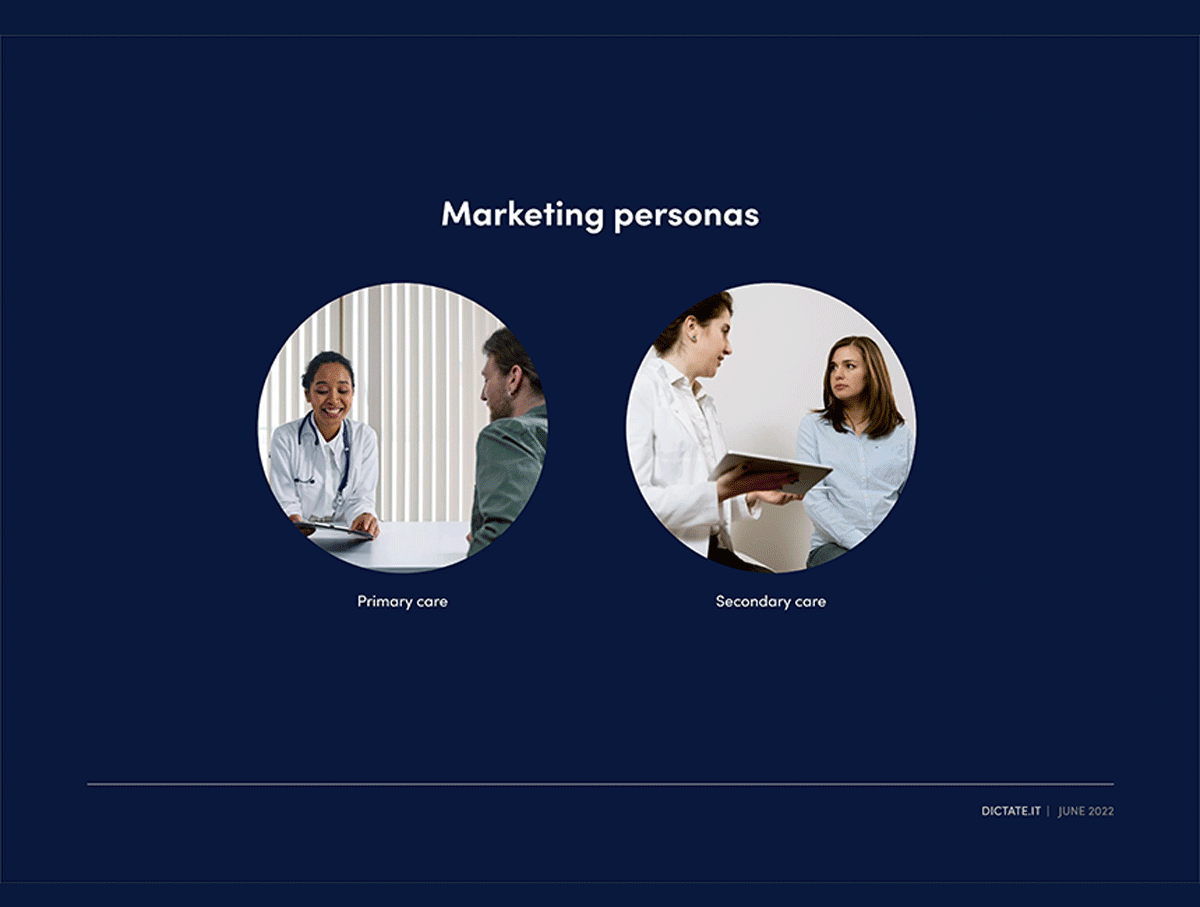
The objective of this phase is to define the full scope of the website, including its design, its features and functionality, its content, and everything else involved.
Your site will be discussed in extensive detail, and then research will be conducted into some key areas that will inform your design and development, such as:
Whether you’re making small updates to an existing design or completely rebranding your business, it’s equally important to use this research to inform every decision you make. That’s because every element of your site’s design must be made to support your business goals and serve your target audience with a great user experience (UX).
This research and planning phase is essential in enabling you and your agency partner to do that.
Phase 2 – Visual Exploration
This exploratory phase involves defining the most appropriate and effective visual direction to take with your site.
The main tool used to help determine the right visual identity for your website is a set of mood boards. These are a visual compilation of different options for colour, typography, structure, images, and other visual components that are used to tell your brand’s story through your website’s design.
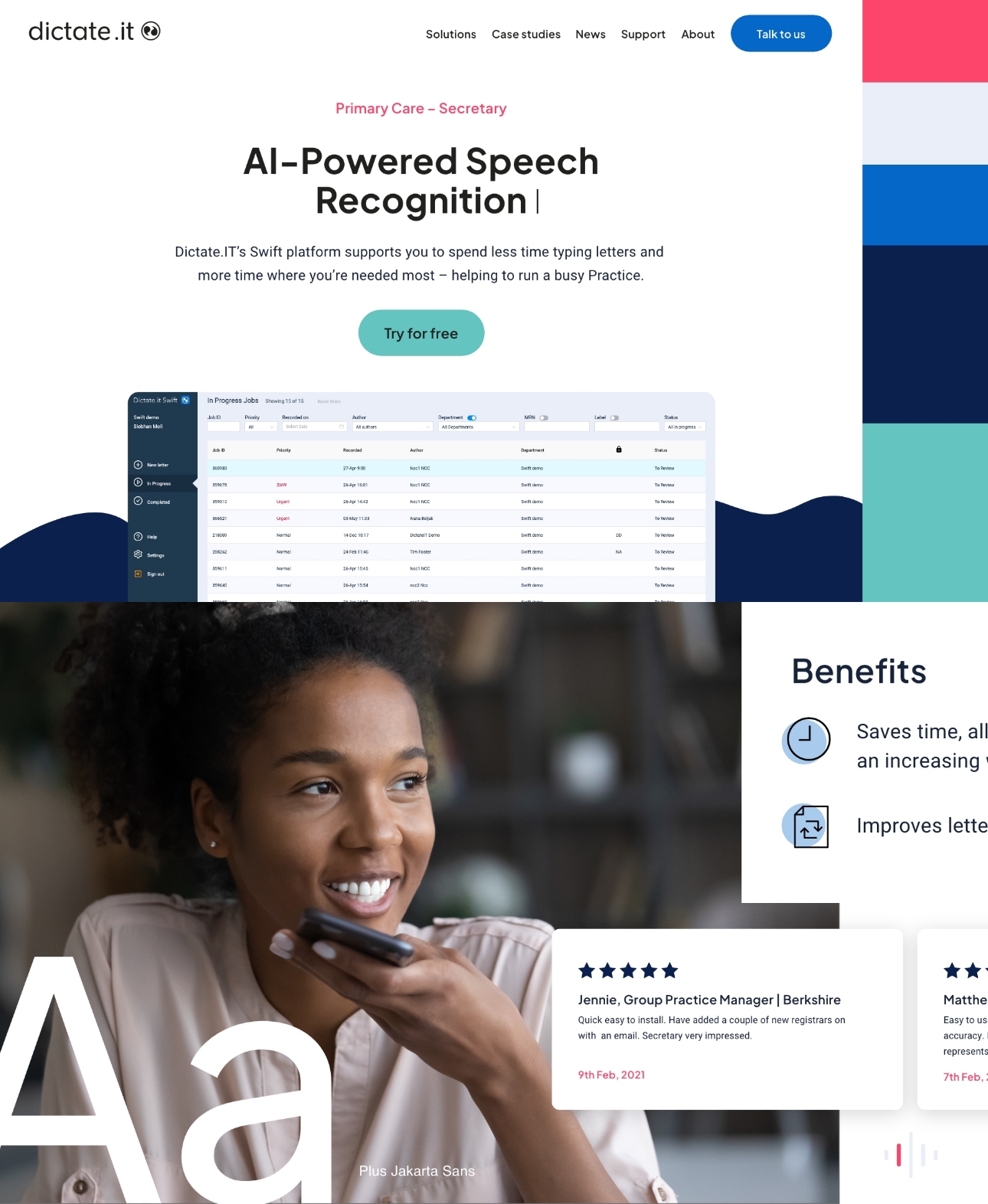
A good agency partner will usually present around three mood boards to help shape the direction, then collaborate with you to narrow it down to one final version.
Visual exploration, like most processes within web design and development, will be collaborative and iterative. You’ll be presented with ideas by your agency partner, then given the chance to provide feedback across several rounds of revisions.
Phase 3 – User Experience (UX) Design
The UX design process is the phase in which you work with your agency’s UX specialist to create a blueprint of the website functionality.
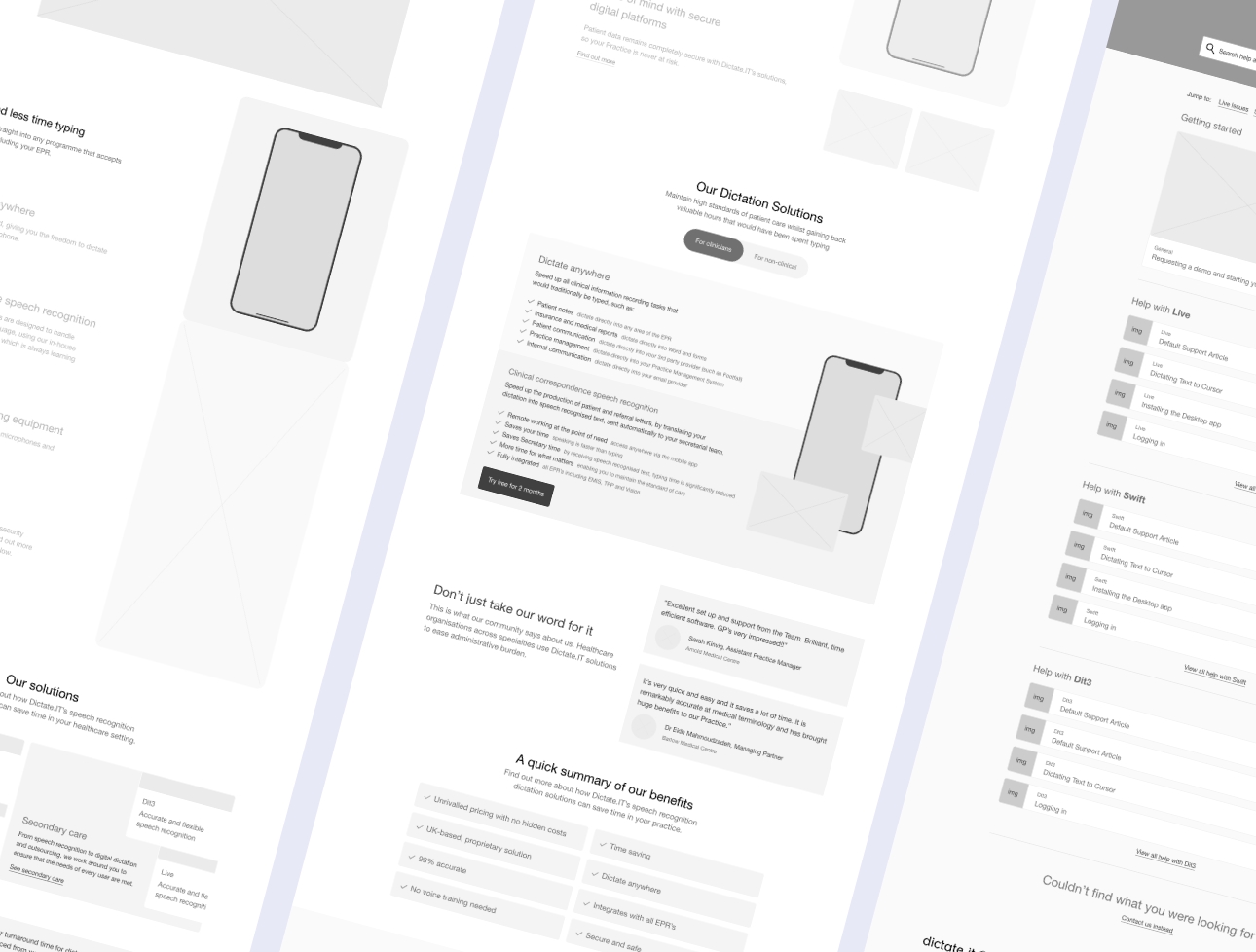
This involves creating wireframes (either low-fidelity or high fidelity) that help you visualise the design and outline your website visitors’ flow through the pages into your main calls-to-action. This is the way the website’s design works strategically to drive outcomes that align with your business goals.
This phase takes place before working on the site’s visual design to ensure the two separate aspects complement each other.
Phase 4 – User Interface (UI) Design
From there, your user interface (UI) will be designed. The styles, fonts, and look and feel of the site from the mood boards will be applied to the wireframes.

Your agency will likely present you with a design for your homepage before moving on to the rest of the site. This will typically be done on a desktop screen size, but it can be done on mobile if you want to take a mobile-first approach. Once this is complete, it will then be designed across the relevant breakpoints.
After completing this process, your agency partner will be ready to enter into developing your website.
Making Complex Processes Simple
As technology continues to become more advanced, more and more of our daily lives now take place in a digital-first context. This means:
In order to succeed, your website’s design requires careful planning, research, and a strategic approach if it hopes to meet the demands of the modern client.
Working with a specialist design and development agency is a proven approach to ensuring you gain a website that meets your requirements and delivers on the expectations of your target audience.
Completing a process like the one outlined in this article will enable you to design a website that can become your clients’ go-to online source when they have a need.
As mentioned earlier, we’ve provided a step-by-step guide to each of these phases to make the process even easier for you.


